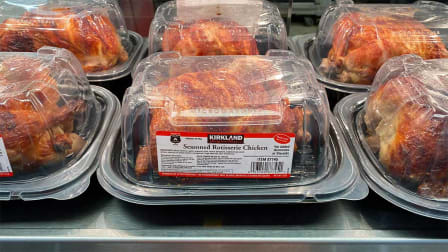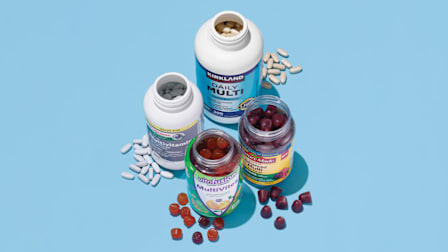What the Health Claims on Food Labels Really Mean
Some are just marketing hype, but these five can help you reach your health goals

Food labels can be confusing, and telling the difference between similar-sounding claims on food packages is sometimes downright baffling. Does “multigrain” mean “whole grain”? Which will have less sugar—a food labeled “reduced sugar” or one labeled “no added sugars”?
You can always get the full picture by checking nutrition facts labels and ingredients lists, but if you know which claims really mean something, you can use them as a shortcut to healthier eating. “Labels can provide a wealth of information, so use them to your advantage,” says Bonnie Taub-Dix, RD, author of “Read It Before You Eat It” (2017). Below are some claims for specific health goals that aren’t just marketing hype.
To Reduce Your Sodium Intake
Food Labels to Look For: “Low Sodium,” “Very Low Sodium”
The bulk of our daily intake of sodium, for most of us, comes from packaged foods. And even just a serving of some of them can contribute a lot to the daily maximum for sodium, which is less than 2,300 mg.
That’s why seeking out foods labeled “low sodium” or “very low sodium” can be helpful. Low-sodium foods have 140 mg or less per serving, and very low-sodium foods have 35 mg or less per serving.
And you might be surprised to learn that foods labeled “no salt added” or “unsalted” aren’t always sodium-free. That’s because these claims simply mean no salt or other sodium source (like baking soda) was added during processing, but some foods contain sodium naturally.
To Scale Back on Added Sugars
Food Labels to Look For: “No Added Sugars,” “Sugar-Free”
“No added sugars” means no sugar of any kind, such as cane sugar, honey, or fruit juice concentrate, was added during processing. The Food and Drug Administration allows the claim to be used on foods that would typically have sugar added to them, such as ice cream, tomato sauce, and ketchup, and on 100 percent fruit juice (because fruit drinks and other alternatives can have added sugars).
To Eat More Whole Grains
Food Label to Look For: “100 Percent Whole Grain”
When buying a package of brown rice or wheat berries, you’re getting a whole grain, even if it’s not pointed out on the label. If a grain claim is made on a bread, cereal, or cracker package, though, “100 percent whole grain” and “100 percent whole wheat” are the ones to count on. Products with a “multigrain” or “made with whole grains” claim can contain refined grains. In fact, in a CR review of packaged breads, fewer than half of the ones labeled with terms like these were 100 percent whole grain.
Why does it matter? Grains have three parts: the endosperm, bran, and germ. Refined flours are made from just the endosperm, while whole grains contain all three parts. And much of a grain’s fiber and other nutrients, such as B vitamins, vitamin E, and healthy fats, are in the bran and germ.
To Get More Fiber
Food Label to Look For: “Excellent Source” of Fiber
For the most part, high-fiber foods are fruits, vegetables, legumes, and other whole foods that don’t always come with a label. But for packaged products, say, cereal and bread—“excellent source of” or “high in” fiber guarantees that you’ll get at least 20 percent of the 28-gram daily value, or 5.5 grams, in a serving of the food. Something that’s a “good source” will have 10 to 19 percent of the daily value. (These claims also mean the same thing for other nutrients, such as calcium and vitamin C.)
The catch, though, is that you should still give the ingredients list a quick read. Manufacturers can add isolated fibers such as chicory, inulin, and psyllium. While these bump up the overall fiber count, you aren’t getting the same nutrients as you would from food that naturally contains fiber. You’ll see these added fibers most often in food such as low-carb flatbreads and wraps, snacks, and drinks. Excess fiber can cause gas, bloating, and cramping, Taub-Dix says, especially if you don’t typically eat these foods, and some people are more sensitive than others.
To Limit Pesticides in Your Diet
Food Label to Look For: USDA Organic Seal
“Foods labeled ‘organic’ haven’t been shown to be nutritionally superior,” Taub-Dix says. For example, they don’t have more vitamins or minerals than conventional ones. But they’re verified to be produced without harmful pesticides and fertilizers. Some of these chemicals, research suggests, may raise the risk of heart disease, Alzheimer’s disease, and other health problems. In addition, animals raised organically must be fed organic feed and not given antibiotics or hormones.
Increasingly, you see a claim like “pesticide-free” or “zero pesticides” on packaged produce. But terms like those have no standardized meaning and aren’t verified. By contrast, organic farms are inspected annually to ensure that they’re adhering to the standards. “Natural” is another claim many people assume means no pesticides, but on packaged foods, it has no clear meaning.
Another way to help keep pesticides out of your diet is to choose conventional fruits and vegetables that have low pesticide residue. In a CR study, almost half the nonorganic fruits and vegetables we looked at, such as broccoli, carrots, and oranges, posed little risk of pesticide exposure.
Editor’s Note: A version of this article also appeared in the May 2023 issue of Consumer Reports On Health.




















